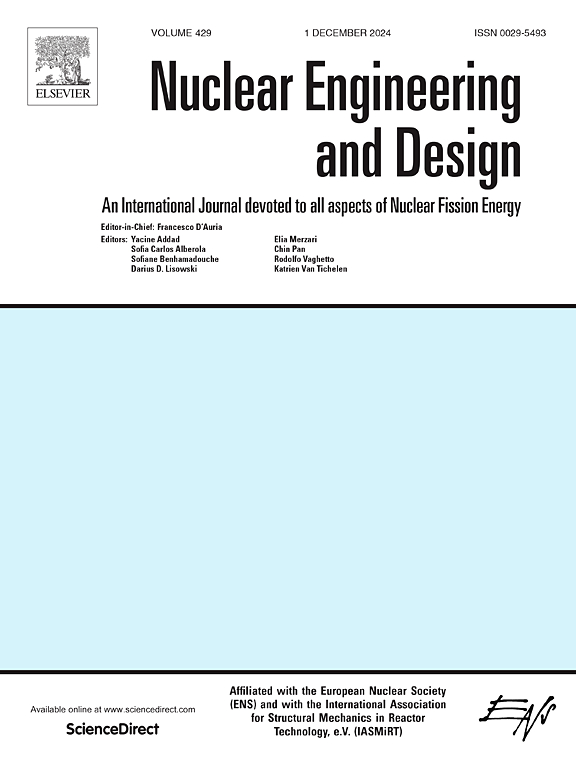Digital engineering workflow for effective management of ITAAC using text analytics and 4D BIM concept for construction of nuclear power plants
IF 2.1
3区 工程技术
Q1 NUCLEAR SCIENCE & TECHNOLOGY
引用次数: 0
Abstract
Ensuring conformity to the Inspections, Tests, Analyses, and Acceptance Criteria (ITAAC), as outlined in the combined license, is a prerequisite for the startup and operation of nuclear facilities within the United States. However, current ITAAC management practices are inefficient due to being voluminous document-centric, susceptible to omission, and laborious to maintain. To address these challenges, this study presents a framework for ITAAC management practices based on 4D Building Information Modeling (BIM) at the building elements level. The proposed framework integrates the building elements and corresponding ITAAC information by extracting properties associated with building elements from Industry Foundation Classes (IFC) files, and the design commitments mentioned in ITAAC documents. This digital integration can then be visualized within the 4D BIM platform. The efficiency and feasibility of the proposed approach, for both the nuclear licensees and the regulatory bodies, are demonstrated in a specific prototype implementation. It allows for the effective identification and verification of the conformity of building components with ITAAC, facilitates real-time tracking of ITAAC completion processes, and improves communication dynamics by incorporating a collaborative environment between licensees and regulators. Additionally, by automating manual tasks such as data entry and documentation management, the framework reduces the time and effort required from personnel. The framework’s feasibility enhances its practicality and applicability in real-world scenarios, further contributing to its effectiveness in streamlining ITAAC management. This research contributes to the field by providing a practical and efficient method to streamline ITAAC management, thereby enhancing the overall reliability and efficiency of nuclear facility licensing processes.
使用文本分析和4D BIM概念进行核电厂建设的ITAAC有效管理的数字化工程工作流程
确保符合合并许可证中概述的检查、测试、分析和验收标准(ITAAC),是美国境内核设施启动和运行的先决条件。然而,当前的ITAAC管理实践效率低下,因为它以大量文档为中心,容易被遗漏,而且维护起来很费力。为了应对这些挑战,本研究提出了一个基于建筑元素级别的四维建筑信息模型(BIM)的ITAAC管理实践框架。该框架通过从工业基础类(IFC)文件和ITAAC文档中提到的设计承诺中提取与建筑元素相关的属性,集成了建筑元素和相应的ITAAC信息。然后,这种数字集成可以在4D BIM平台中可视化。在一个具体的原型实施中,证明了所提议的方法对核许可证持有者和监管机构的效率和可行性。它允许有效地识别和验证建筑组件与ITAAC的一致性,促进ITAAC完成过程的实时跟踪,并通过纳入许可人与监管机构之间的协作环境来改善沟通动态。此外,通过自动化手动任务,例如数据输入和文档管理,该框架减少了人员所需的时间和精力。该框架的可行性增强了其在现实场景中的实用性和适用性,进一步有助于简化ITAAC管理的有效性。本研究为简化ITAAC管理提供了一种实用而有效的方法,从而提高了核设施许可流程的整体可靠性和效率,从而为该领域做出了贡献。
本文章由计算机程序翻译,如有差异,请以英文原文为准。
求助全文
约1分钟内获得全文
求助全文
来源期刊

Nuclear Engineering and Design
工程技术-核科学技术
CiteScore
3.40
自引率
11.80%
发文量
377
审稿时长
5 months
期刊介绍:
Nuclear Engineering and Design covers the wide range of disciplines involved in the engineering, design, safety and construction of nuclear fission reactors. The Editors welcome papers both on applied and innovative aspects and developments in nuclear science and technology.
Fundamentals of Reactor Design include:
• Thermal-Hydraulics and Core Physics
• Safety Analysis, Risk Assessment (PSA)
• Structural and Mechanical Engineering
• Materials Science
• Fuel Behavior and Design
• Structural Plant Design
• Engineering of Reactor Components
• Experiments
Aspects beyond fundamentals of Reactor Design covered:
• Accident Mitigation Measures
• Reactor Control Systems
• Licensing Issues
• Safeguard Engineering
• Economy of Plants
• Reprocessing / Waste Disposal
• Applications of Nuclear Energy
• Maintenance
• Decommissioning
Papers on new reactor ideas and developments (Generation IV reactors) such as inherently safe modular HTRs, High Performance LWRs/HWRs and LMFBs/GFR will be considered; Actinide Burners, Accelerator Driven Systems, Energy Amplifiers and other special designs of power and research reactors and their applications are also encouraged.
 求助内容:
求助内容: 应助结果提醒方式:
应助结果提醒方式:


